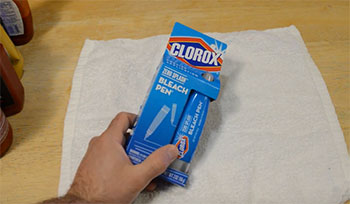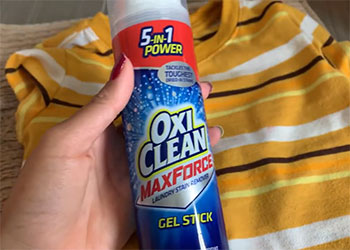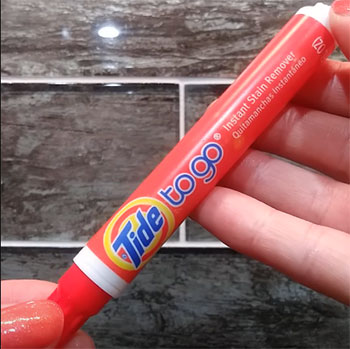In the world of stain-fighting and spot-cleaning, the Clorox Bleach Pen has long reigned supreme. But what happens when this trusty tool becomes hard to find or doesn’t quite fit your needs?
Fear not, fellow clean freaks! We’re about to embark on a journey through the land of Clorox Bleach Pen alternatives, uncovering hidden gems and DIY solutions that’ll have your whites whiter and your stains running for the hills.
The Bleach Pen Predicament

Before we discuss about the alternatives, let’s address the elephant in the room: the elusive Clorox Bleach Pen. Once a staple in many cleaning arsenals, this precision stain-fighter has become increasingly difficult to find on store shelves.
Whether due to supply chain issues, changing consumer preferences, or whispers of discontinuation, the struggle to get our hands on these pens is real.
But here’s the thing – necessity is the mother of invention, and boy, have we got some inventive alternatives for you! From commercial products to DIY solutions, we’re about to open up a whole new world of spot-cleaning possibilities.
Commercial Alternatives: The Ready-to-Use Champions
OxiClean Max Force Gel Stick
Pros:

- Powerful stain-fighting formula
- Easy-to-use gel stick applicator
- Safe on colors
- Works on a variety of fabrics
Cons:
- Not as precise as a pen tip
- May require more product per use
- Not as effective on mold or mildew
First up in our lineup of commercial alternatives is the OxiClean Max Force Gel Stick. This bad boy packs a serious punch when it comes to tackling tough stains. The gel formula clings to fabric fibers, allowing the stain-fighting agents to work their magic.
What sets this apart from our beloved bleach pen is its versatility. While the Clorox pen is primarily for whites, the OxiClean stick is safe on colors. So whether you’ve spilled coffee on your favorite white shirt or dribbled spaghetti sauce on a colorful blouse, this stick has got your back.
The applicator, while not as precise as a pen tip, still allows for targeted stain treatment. You might find yourself using a bit more product compared to the bleach pen, but the trade-off is a wider range of use cases.
One downside? It’s not as effective on mold or mildew as bleach. So for those bathroom tile grout stains, you might need to look elsewhere.
Tide To Go Instant Stain Remover Pen
Pros:

- Compact and portable
- Precise pen-tip applicator
- Safe for most colorfast fabrics
- Quick-acting formula
Cons:
- Small amount of product per pen
- Not as effective on set-in stains
- Not suitable for use on whites as a bleaching agent
Ah, the Tide To Go pen – the pocket-sized superhero of the stain-fighting world. This little wonder closely mimics the precision of the Clorox Bleach Pen, making it a favorite for on-the-go stain emergencies.
The pen-tip applicator allows for pinpoint accuracy, perfect for those small, annoying spots that always seem to appear right before an important meeting. Its compact size means you can stash one in your purse, car, or desk drawer for stain-fighting on the fly.
However, it’s important to note that while the Tide pen is a stain remover, it’s not a bleaching agent like the Clorox pen. It’s great for fresh stains on colorfast fabrics but don’t expect it to brighten your whites or tackle set-in stains with the same gusto as its bleach-based counterpart.
The small size is a double-edged sword – super portable, but you might find yourself going through these pens quicker than you’d like, especially if you’re a frequent user.
Resolve Gold Oxi Action Laundry Stain Remover Gel
Pros:
- Powerful oxi-action formula
- Works on both whites and colors
- Effective on a wide range of stains
- Large bottle for multiple uses
Cons:
- Less precise application than a pen
- Requires a bit more effort to use effectively
- May need to be washed out more thoroughly
Next up is the Resolve Gold Oxi Action Laundry Stain Remover Gel. This powerhouse brings the strength of oxygen-based cleaning to your laundry room, tackling everything from grass stains to red wine spills.
The gel formula is designed to penetrate deep into fabric fibers, lifting stains from the inside out. It’s safe for use on both whites and colors, making it a versatile addition to your cleaning toolkit.
One of the biggest advantages of this product is its size. Unlike the small Clorox pens or Tide To Go sticks, you get a hefty bottle that’ll last through many stain emergencies. However, this also means it’s less portable and not as convenient for quick touch-ups outside the home.
The application is a bit less precise than a pen, requiring you to squeeze out the gel and work it into the stain with the nozzle or your fingers. This means a bit more effort on your part, but the results can be well worth it for tough stains.
Just remember to rinse or wash the treated area thoroughly – the powerful formula can leave residue if not properly removed.
DIY Solutions: The Homemade Heroes
Homemade Bleach Gel Pen
Pros:
- Cost-effective
- Customizable strength
- Uses readily available household items
- Eco-friendly (reusable container)
Cons:
- Requires preparation time
- May not be as stable as commercial products
- Potential for mess if not stored properly
Ready to channel your inner chemist? Let’s whip up a homemade bleach gel pen that’ll have you wondering why you ever bought the commercial version!
Here’s what you’ll need:
- 1/2 cup cornstarch
- 3/4 cup water
- 1/4 cup bleach
- Empty squeeze bottle or old glue bottle
Mix the cornstarch with 1/4 cup of water in a saucepan. Heat over medium, stirring constantly until it forms a thick paste. Remove from heat and let it cool. Once cool, stir in the remaining water and bleach. Pour into your squeeze bottle, and voila! Your very own bleach gel pen.
The beauty of this DIY version is its customizability. You can adjust the bleach concentration to suit your needs or even experiment with adding a few drops of essential oil for a pleasant scent (just be careful not to use too much, as oils can stain).
The downside? It takes a bit of time to prepare, and the mixture may not be as stable as commercial products. You’ll need to shake it well before each use and store it in a cool, dark place to maintain its effectiveness.
Lemon Juice and Sunlight Combo
Pros:
- All-natural solution
- Gentle on fabrics
- No harsh chemicals
- Pleasant citrus scent
Cons:
- Slower acting than bleach
- Only effective on certain types of stains
- Requires sunlight for best results
For those looking for a gentler, all-natural approach, the lemon juice and sunlight method is a classic for a reason. This dynamic duo can work wonders on certain types of stains, especially on white or light-colored fabrics.
Simply squeeze fresh lemon juice onto the stain, then expose the fabric to direct sunlight. The citric acid in the lemon juice, activated by the sun’s UV rays, creates a natural bleaching effect.
This method is fantastic for those with sensitive skin or environmental concerns, as it uses no harsh chemicals. Plus, who doesn’t love the fresh scent of lemons?
However, patience is key here. This method works more slowly than chemical bleaches and may require multiple applications for tough stains. It’s also not as effective on darker stains or colored fabrics, where you might end up with a light spot.
Hydrogen Peroxide and Dish Soap Mixture
Pros:
- Effective on a variety of stains
- Safer than chlorine bleach
- Affordable ingredients
- Can be used on colors (with caution)
Cons:
- Not as powerful as chlorine bleach
- May require longer treatment time
- Can still cause color fading if overused
Here’s another DIY gem that packs a punch against stubborn stains. Mix equal parts hydrogen peroxide and liquid dish soap in a small bowl or container. Apply this mixture directly to the stain using an old toothbrush or cloth.
This powerhouse combo works wonders on everything from grass stains to sweat marks. The hydrogen peroxide acts as a mild bleaching agent, while the dish soap helps to break down and lift the stain.
One of the biggest advantages of this mixture is its relative safety compared to chlorine bleach. It’s less likely to damage fabrics and can even be used cautiously on colored items (always test in an inconspicuous area first!).
The trade-off is that it may not be as instantly effective as chlorine bleach, especially on really tough stains. You might need to let it sit longer or repeat the treatment for best results.
Specialty Products: The Niche Ninjas
Oxygen Bleach Powder
Pros:
- Safe on colors
- Environmentally friendly
- Versatile (can be used for laundry and household cleaning)
- No harsh smell
Cons:
- Needs to be mixed with water before use
- May not be as effective on certain stains as chlorine bleach
- Requires longer soaking time for best results
Oxygen bleach powder, like OxiClean or Biokleen Oxygen Bleach Plus, is a fantastic alternative for those looking for a more versatile and eco-friendly option.
Unlike chlorine bleach, oxygen bleach is safe to use on colored fabrics (always test first, though!). It works by releasing oxygen ions when mixed with water, which break down stain molecules without harsh chemicals.
The versatility of oxygen bleach is one of its biggest selling points. You can use it for spot-treating stains, as a laundry booster, or even for general household cleaning. Plus, it doesn’t have that strong, chemical smell associated with traditional bleach.
The downside? It’s not quite as powerful as chlorine bleach on really tough stains, and it requires a bit more prep work since you need to mix it with water before use. For best results, you often need to let stained items soak for a while, which might not be ideal for quick fixes.
Bleach Gel for Grout
Pros:
- Specially formulated for tile and grout
- Clings to vertical surfaces
- Powerful mold and mildew fighter
- Often comes with a precision applicator
Cons:
- Limited to specific surfaces
- Strong chemical smell
- Can be harsh on skin and eyes
- Not suitable for colored grout
For those missing their Clorox Bleach Pen specifically for tackling grimy grout lines, fear not! There are specialty bleach gels designed just for this purpose.
Products like Zep Grout Cleaner and Whitener or Clorox Toilet Bowl Cleaner with Bleach Gel can be excellent alternatives. These thick gels are formulated to cling to vertical surfaces, making them perfect for tile walls and backsplashes.
The precision applicator (often a angled nozzle) allows you to target those narrow grout lines with accuracy rivaling the Clorox pen. Plus, the powerful bleach formula makes quick work of mold, mildew, and other stubborn grout stains.
However, these products are pretty specialized. They’re not suitable for fabric stains and should only be used on non-porous surfaces like tile and grout. The strong chemical smell and potential for skin irritation mean you’ll need to use these with caution and good ventilation.
The Art of Application: Mastering Your Chosen Alternative
Now that we’ve explored a smorgasbord of Clorox Bleach Pen alternatives, let’s talk technique. After all, even the best product can fall short if not used correctly.
- Act Fast: With most stains, time is of the essence. The sooner you attack that spot, the better your chances of complete removal.
- Test First: Always, always test your chosen alternative on an inconspicuous area first, especially when dealing with colored fabrics or surfaces.
- Be Patient: Unlike the quick-action Clorox pen, some alternatives might require a bit more time to work their magic. Don’t be afraid to let the product sit for a few minutes (or even overnight for tough stains).
- Rinse Thoroughly: Whether you’re using a commercial product or a DIY solution, make sure to rinse the treated area thoroughly. Leftover cleaning agents can attract dirt or cause discoloration over time.
- Combine Methods: Sometimes, the best approach is a tag-team effort. For example, you might use the hydrogen peroxide and dish soap mixture followed by sunlight exposure for extra oomph.
- Know When to Fold ‘Em: Some stains are just too stubborn for at-home treatment. If you’ve given it your all and that spot still won’t budge, it might be time to call in the professionals.
Also Read: Tilex Vs. Clorox: Which Cleaner Should You Choose?
FAQ: Clearing Up the Confusion
Several products can mimic the precision and stain-fighting power of a bleach pen:
1. Tide To Go Instant Stain Remover Pen
2. OxiClean Max Force Gel Stick
3. DIY bleach gel in a squeeze bottle
4. Hydrogen peroxide and dish soap mixture in a small bottle with a fine tip
5. Specialty grout cleaning gels with precision applicators
While none of these are exact replicas of the Clorox Bleach Pen, they can be effective alternatives depending on your specific needs.
As of my last update, Clorox has not officially announced the discontinuation of their Bleach Pen. However, many consumers have reported difficulty finding the product in stores. This could be due to supply chain issues, changes in production priorities, or possibly a phasing out of the product. For the most up-to-date information, it’s best to check Clorox’s official website or contact their customer service directly.
Yes, Clorox does make (or at least has made) the Clorox Bleach Pen. It’s been a popular product for spot-treating stains, especially on white fabrics and for cleaning grout. However, as mentioned earlier, availability has become an issue in recent times. If you can’t find it in stores, consider trying one of the alternatives we’ve discussed in this article.
If you’re having trouble finding Clorox bleach products, including the Bleach Pen, there could be several reasons:
Supply Chain Issues: The COVID-19 pandemic has caused disruptions in manufacturing and distribution for many products, including cleaning supplies.
Increased Demand: Cleaning products have seen surges in demand, which can lead to temporary shortages.
Production Shifts: Companies sometimes shift production priorities based on market demands or strategic decisions.
Local Stock Issues: Sometimes, the issue might be specific to your local stores rather than a widespread shortage.
Possible Discontinuation: While not confirmed for the Bleach Pen, companies occasionally discontinue products without much fanfare.
If you’re specifically looking for Clorox bleach products, you might try checking different stores, looking online, or reaching out to Clorox directly for information on availability in your area. Remember, there are also many effective alternatives available if you can’t find your usual Clorox products.
Conclusion: A Bright Future for Stain-Fighting
As we’ve discovered, the world of stain-fighting extends far beyond the Clorox Bleach Pen. Whether you opt for a commercial alternative, dive into DIY solutions, or explore specialty products, there’s a whole arsenal of weapons at your disposal in the war against stains.
Remember, the “best” alternative will depend on your specific needs, the types of stains you commonly face, and your personal preferences regarding chemical versus natural solutions. Don’t be afraid to experiment with different options to find your perfect stain-fighting match.
As we move towards more eco-conscious and health-aware cleaning practices, it’s exciting to see the innovations and alternatives emerging in the market. Who knows? Your next favorite stain-fighter might not even have been invented yet!
So go forth, armed with your new knowledge, and show those stains who’s boss. Your whites will be brighter, your colors more vibrant, and your surfaces sparkling clean. And who needs a Clorox Bleach Pen when you’ve got all these amazing alternatives up your sleeve?
